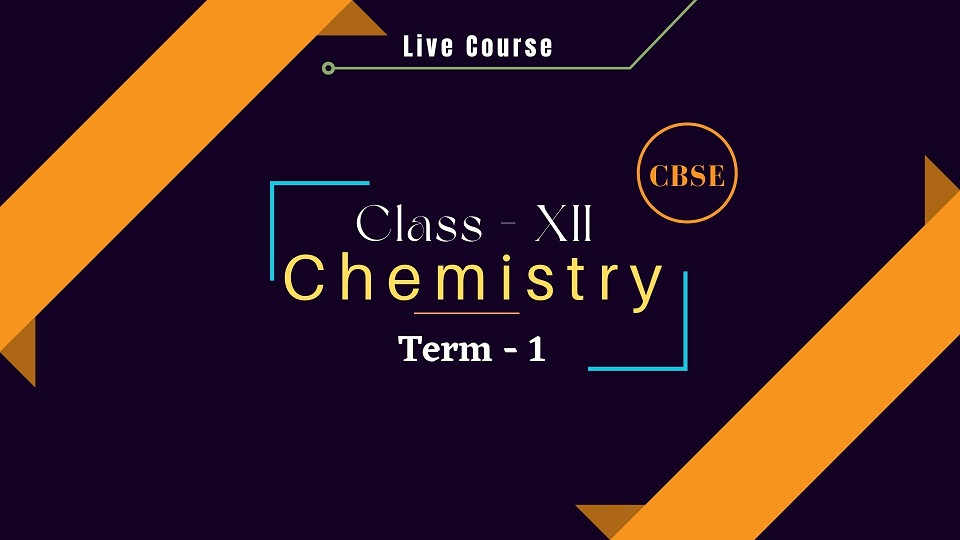Course Schedule
Start Date : 21 April 2022
Course Weightage
| S. No. | Title | Marks |
| 1 | Solid State | 10 |
| 2 | Solutions | |
| 3 | p -Block Elements | 10 |
| 4 | Haloalkanes and Haloarenes | 15 |
| 5 | Alcohols, Phenols and Ethers | |
| 6 | Biomolecules | |
| Total | 35 |
Course Features
- Lectures 85
- Quiz 0
- Duration 12 weeks
- Skill level All levels
- Language English
- Students 0
- Certificate No
- Assessments Yes
- 6 Sections
- 85 Lessons
- 12 Weeks
- Unit I: Solid State11
- 2.1Classification of solids – LC -1
- 2.1Classification of solids – LC -2
- 2.1Amorphous and crystalline solids
- 2.1Unit cell in two dimensional
- 2.1Three dimensional lattices
- 2.1Calculation of density of unit cell
- 2.1Packing in solids
- 2.1Packing efficiency
- 2.1Voids
- 2.1Number of atoms per unit cell in a cubic unit cell
- 2.1Point defects
- Unit II: Solutions10
- Unit VII: p-Block Elements33
- 4.1Group -15 Elements: General introduction
- 4.1Group -15 Elements: Electronic configuration
- 4.1Group -15 Elements: Occurrence
- 4.1Group -15 Elements: Oxidation states
- 4.1Group -15 Elements: Trends in physical and chemical properties
- 4.1Group -15 Elements: Nitrogen preparation properties and uses
- 4.1Group -15 Elements: Compounds of Nitrogen
- 4.1Group 16 Elements: General introduction
- 4.1Group -16 Elements: Electronic configuration
- 4.1Group -16 Elements: Oxidation states
- 4.1Group -16 Elements: Occurrence
- 4.1Group -16 Elements: Trends in physical and chemical properties
- 4.1Group -16 Elements: dioxygen: preparation, properties and uses
- 4.1Group -16 Elements: classification of Oxides
- 4.1Group -16 Elements: Ozone
- 4.1Group -16 Elements: Sulphur – allotropic forms
- 4.1Group -16 Elements: compounds of Sulphur
- 4.1Group -16 Elements: Preparation properties and uses of Sulphur-dioxide
- 4.1Group -16 Elements: Sulphuric Acid: properties and uses
- 4.1Group -16 Elements: Oxoacids of Sulphur
- 4.1Group -17 Elements: General introduction
- 4.1Group -17 Elements: Electronic configuration
- 4.1Group -17 Elements: Oxidation states
- 4.1Group -17 Elements: Occurrence
- 4.1Group -17 Elements: Trends in physical and chemical properties
- 4.1Group -17 Elements: compounds of halogens
- 4.1Group -17 Elements: Preparation, properties and uses of Chlorine
- 4.1Group -17 Elements: Interhalogen compounds
- 4.1Group -17 Elements: Oxoacids of halogens
- 4.1Group -18 Elements: General introduction
- 4.1Group -18 Elements: Electronic configuration
- 4.1Group -18 Elements: Occurrence
- 4.1Group -18 Elements: Trends in physical and chemical properties
- Unit X: Haloalkanes and Haloarenes6
- Unit XI: Alcohols, Phenols and Ethers16
- 6.1Alcohols: Nomenclature
- 6.1Alcohols: Methods of preparation
- 6.1Alcohols: Physical and chemical properties (of primary alcohols only)
- 6.1Alcohols: Identification of primary
- 6.1Alcohols: Secondary and Tertiary alcohols
- 6.1Alcohols: Mechanism of dehydration
- 6.1Phenols: Nomenclature
- 6.1Phenols: Methods of preparation
- 6.1Phenols: Physical and chemical properties
- 6.1Acidic nature of phenol
- 6.1Electrophilic substitution reactions
- 6.1Uses of phenols
- 6.1Ethers: Nomenclature
- 6.1Ethers: Methods of preparation
- 6.1Ethers: Physical and chemical properties
- 6.1Ethers: Uses
- Unit XIV: Biomolecules9
- 7.1Carbohydrates – Classification (aldoses and ketoses)
- 7.1Monosaccharides (glucose and fructose)
- 7.1D-L configuration
- 7.1Proteins -Elementary idea of – amino acids
- 7.1Proteins -Elementary idea of peptide bond
- 7.1Proteins -Elementary idea of polypeptides
- 7.1Structure of proteins – primary, secondary, tertiary structure and quaternary structures
- 7.1Denaturation of proteins
- 7.1Nucleic Acids: DNA and RNA






